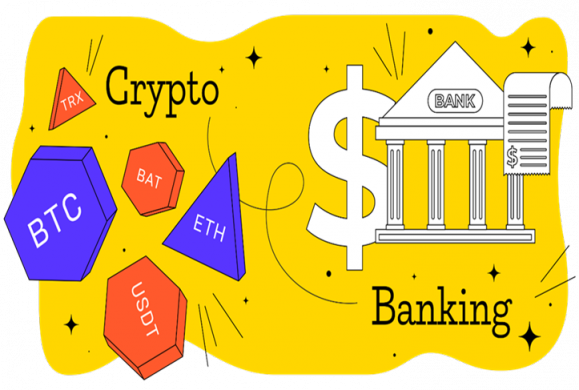Crypto, which is short for “cryptocurrency”, is changing the way that we bank. Banks have mixed feelings when it comes to crypto. Some banks are in favour of cryptocurrency, while others are completely against it. There are various reasons for this.

Cryptocurrency is enabled by the existence of blockchain technology. Crypto is changing the way we bank by building a decentralised database of digital and unique assets. The whole blockchain and crypto process could potentially eliminate the need for banks entirely.
Financial companies are getting increasingly interested in finding blockchain developers who can develop new solutions for the banking industry. Blockchain developers provide organisations with a lot of benefits. There are different types of blockchain platforms, like Polkadot. There are companies where you can hire polkadot developers, and other blockchain developers, for your organisation.
What Is Blockchain?
Blockchain is a shared database or ledger. Pieces of data are stored in data structures known as blocks, and each node of the network has an exact replica of the entire database. Security is ensured, because if someone tries to change or delete an entry on one copy of the ledger, none of the others will show this alteration and it will be rejected. Blockchain technology enables the existence of cryptocurrency. They are created by blockchain developers, who develop and manage decentralised applications (dApps), as well as create new blockchain platforms.
There are public blockchains and private blockchains. A public blockchain is an open and permissionless blockchain, where anybody can join the network freely and establish a node. Due to the open nature of these blockchains, they are secured with cryptography and a consensus system like proof of work (PoW). Private blockchains are also called permissioned blockchains, and require each node to be approved before joining. These nodes are deemed trustworthy, and therefore the layers of security do not need to be as heavy.
What Is Cryptocurrency?
Cryptocurrency is a medium of exchange which is created and stored electronically on the blockchain. It uses cryptographic techniques to verify the transfer of funds, and an algorithm to control the creation of monetary units. It has no intrinsic value seeing as it is not redeemable for another commodity, like gold. Crypto also has no physical form and only exists in the network. The supply of crypto is determined by protocol, not a central bank, and the network is entirely decentralised.
Cryptocurrency can be grouped into two separate categories: coins and tokens. A coin is any crypto that uses its own blockchain infrastructure. Tokens use another blockchain’s infrastructure. There are various different types of cryptocurrencies, including Bitcoin, Ether, Polkadot, Tether, Solana, and many others.
Cryptocurrency And Banking
Cryptocurrencies could offer benefits to financial institutions, customers, and the banking sector. But there are those who consider blockchain to be a disruptive force in the finance sector, especially when it comes to the functions of payments and banking. Banks believe that the risk of cryptocurrencies outweighs the benefits. Because of the decentralised nature of cryptocurrency, it is believed to undermine the power of central banks. Banks believe that they won’t be needed anymore, or that they will be unable to control the supply of money. Banks think that crypto transactions can’t be tracked because they don’t have anti-money laundering (AML) and KYC regulations regarding digital currency transactions. Due to the unstable prices of crypto, banks believe they might not remain stable enough to become investments.
Blockchain technology, which crypto is based on, allows untrusted parties to agree on the state of a database, without using a middleman. By providing a ledger that no one administers, a blockchain could provide specific financial services, such as payments or securitisation, without the need for a bank. Blockchain allows for the use of tools like “smart contracts”, which are self-executing contracts based on the blockchain. These contracts could potentially automate manual processes.
Blockchain technology and distributed ledger technology (DLT) have a big opportunity to disrupt the banking industry by getting rid of the middleman in the key services that banks provide.
- Payments. By establishing a decentralised ledger for payments, blockchain technology could facilitate faster payments at lower fees than banks. It offers a secure and cheap way of sending payments that cut down on the need for verification from third parties, and beats processing times for traditional bank transfers.
- Clearance and Settlement Systems. Distributed ledgers can reduce operational costs and bring us closer to real-time transactions between financial institutions. Distributed ledger technology (DLT) could allow transactions to be settled directly and keep track of them better than existing protocols.
- Fundraising. Initial Coin Offerings (ICOs) are experimenting with a new model of financing that unbundled access to capital from traditional capital-raising services and firms. In ICOs, entrepreneurs raise money by selling tokens or coins, allowing them to fundraise without a traditional investor.
- Securities. By tokenizing traditional securities, like stocks, bonds, and alternative assets, and placing them on public blockchains, blockchain technology could create more efficient, interoperable capital markets. Blockchain technology removes the middleman in asset rights transfers, lowering asset exchange fees, giving access to wider global markets, and reducing the instability of the traditional securities market.
- Loans and Credit. By removing the need for gatekeepers in the loan and credit industry, blockchain technology can make it more secure to borrow money and provide lower interest rates. Blockchain-enabled lending offers a more secure way of offering personal loans to a larger group of consumers. It also makes the loan process cheaper, more efficient, and more secure.
- Trade Finance. By replacing the bills of lading process in the trade finance industry, blockchain technology can create more transparency, security, and trust among trade parties on a global level. The use of this technology can support cross-border trade transactions that would have been uneconomical due to trade costs and documentation processes. It would also shorten delivery times and reduce paper use.
- Customer KYC and Fraud Prevention. By storing customer information on decentralised blocks, blockchain technology can make it easier and safer to share information between financial institutions.
Conclusion
This article demonstrates how crypto is changing the way we bank. It describes what blockchain technology is and how it works. Cryptocurrency is explained, as well as that there are different types thereof. Cryptocurrency and the roles it plays, or could be playing, in banking are described.

 Hot Features
Hot Features











